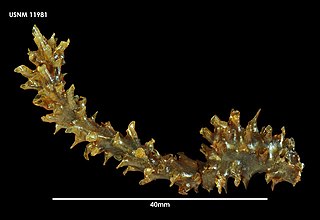
Hemichordata is a phylum which consists of triploblastic, enterocoelomate, and bilaterally symmetrical marine deuterostome animals, generally considered the sister group of the echinoderms. They appear in the Lower or Middle Cambrian and include two main classes: Enteropneusta, and Pterobranchia. A third class, Planctosphaeroidea, is known only from the larva of a single species, Planctosphaera pelagica. The class Graptolithina, formerly considered extinct, is now placed within the pterobranchs, represented by a single living genus Rhabdopleura.

Graptolites are a group of colonial animals, members of the subclass Graptolithina within the class Pterobranchia. These filter-feeding organisms are known chiefly from fossils found from the Middle Cambrian through the Lower Carboniferous (Mississippian). A possible early graptolite, Chaunograptus, is known from the Middle Cambrian. Recent analyses have favored the idea that the living pterobranch Rhabdopleura represents an extant graptolite which diverged from the rest of the group in the Cambrian.

Pterobranchia, members of which are often called pterobranchs, is a class of small worm-shaped animals. They belong to the Hemichordata, and live in secreted tubes on the ocean floor. Pterobranchia feed by filtering plankton out of the water with the help of cilia attached to tentacles. There are about 25 known living pterobranch species in three genera, which are Rhabdopleura, Cephalodiscus, and Atubaria. On the other hand, there are several hundred extinct genera, some of which date from the Cambrian Period.
Roman Stanisław Jakub Kozłowski was a Polish palaeontologist, best known for his work on graptolites.

Rhabdopleurida is one of three orders in the class Pterobranchia, which are small, worm-shaped animals, are the only surviving graptolites. Members belong to the hemichordates. Species in this order are sessile, colonial, connected with a stolon, living in clear water and secrete tubes called tubarium. They have a single gonad, the gill slits are absent and the collar has two tentaculated arms. Rhabdopleura is the best studied pterobranch in developmental biology. Rhabdopleura is the only extant graptolite.

Rhabdopleura is a genus of colonial sessile hemichordates belonging to the Pterobranchia class. As one of the oldest living genera with a fossil record dating back to the Middle Cambrian, it is also considered to be the only living genus of graptolites.

Cephalodiscus is a genus of hemichordates in the monotypic family Cephalodiscidae of the order Cephalodiscida.
Atubaria heterolopha is a species of hemichordates in the monotypic genus Atubaria and in the monotypic family Atubaridae. This taxon belongs to the pterobranchian order Cephalodiscida. It was described by Tadao Sato in 1936 from specimens found feeding on a colony of the hydrozoan Dycoryne conferta in Sagami Bay, Japan.
Rhabdopleura annulata is a sessile hemichordate. It is a suspension feeder that secretes tubes on the ocean floor.

Rhabdopleura compacta is a sessile hemichordate. It is a suspension feeder that secretes tubes on the ocean floor.
Rhabdopleura striata is a sessile hemichordate. It is a suspension feeder that secretes tubes on the ocean floor.
Abrograptidae is an extinct family of graptolites from the Middle Ordovician.
Didymograptidae is an extinct family of graptolites.
Glossograptidae is an extinct family of graptolites.
Acanthograptidae is an extinct family of graptolites.
Cysticamaridae is an extinct family of graptolites.
Wimanicrustidae is an extinct family of graptolites.
Cyclograptidae is an extinct family of graptolites.
Cephalodiscus levinsoni is a sessile hemichordate belonging to the order Cephalodiscida.
Cephalodiscus sibogae is a sessile hemichordate belonging to the order Cephalodiscida. Sightings of the species has been reported only once.
Harmer. S. F. 1905. The Pterobranchia ol the Siboga-Expedition. Siboga Exped. Monogr. 26. 1-131






